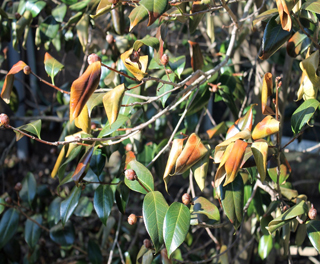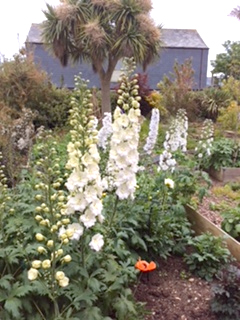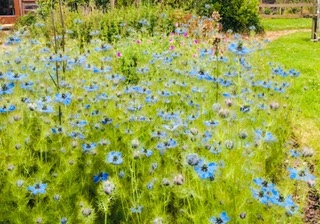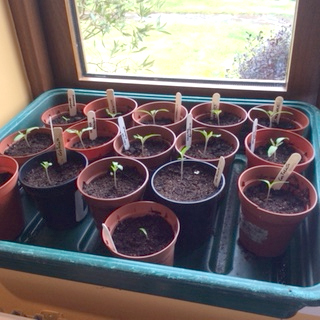 We’ve had a rotten start to the year so far, in many ways, but surely April will give we gardeners a taste of warmer weather and hope for a better season? Normally, most of us will have got ahead in March with some seed planting and general garden fettling, but with the Beasts, Mini Beasts and Emma trying to thwart us at every turn, we suspect we are all behind where we want to be. Oh well, if you want something done, give it to a busy person, so they say, and there is so much to do this month, we are all going to be busy people!
We’ve had a rotten start to the year so far, in many ways, but surely April will give we gardeners a taste of warmer weather and hope for a better season? Normally, most of us will have got ahead in March with some seed planting and general garden fettling, but with the Beasts, Mini Beasts and Emma trying to thwart us at every turn, we suspect we are all behind where we want to be. Oh well, if you want something done, give it to a busy person, so they say, and there is so much to do this month, we are all going to be busy people!
On the subject of Beasts and snow, we are guessing that some of your plants are looking somewhat forlorn at the moment. Early bloomers and evergreens have been nipped and crisped, and some more tender specimens look like they’ll never recover. Take heart though, because unsightly as some of it may be at the moment, by and large they will not have succumbed to the conditions. Evergreens such as pittosporum or photinia (Red Robin) can be tidied up in a few weeks’ time when the risk of frost has passed, and some can be cut back hard if the damage is all over the plant. We have some plants (eg ceanothus, cornus capitata) where the leaves have nigh on vanished or crisped all over. They will almost certainly reshoot, and soon, but we’ll have to tolerate them looking rubbish for this year.
 Some more tender plants (euphorbia mellifera and melianthus major, for example) can stand to be cut right down to the ground because they will reshoot from the base with lovely new stems. Just remember that everything you cut back hard should also get a feed, as you will be asking it to do an awful lot this year. A good liquid feed, a handful of fast-acting chicken manure, or blood fish and bone will do it.
Some more tender plants (euphorbia mellifera and melianthus major, for example) can stand to be cut right down to the ground because they will reshoot from the base with lovely new stems. Just remember that everything you cut back hard should also get a feed, as you will be asking it to do an awful lot this year. A good liquid feed, a handful of fast-acting chicken manure, or blood fish and bone will do it.
If the weather is reasonable, the ground should be warming up nicely so now is a great time to get herbaceous perennials in the ground. These are plants which come back year after year; well, most do if they haven’t had to swim all winter, but they don’t go woody like a tree or shrub. These are great plants for adding colour to a garden; they come in all shapes and sizes and there is something for every garden position.
If you have an area in your garden which is, perhaps, all spring-flowering, consider using perennials to give you later colour – for example, phlox for scent and summer colour, Japanese anemones for late summer colour, Michaelmas daisies for the autumn. At this time of year, they are often available in small pots which offer great value for money. If you can squeeze in more than one specimen, always plant in odd numbers. And it’s worth remembering that bigger clumps of fewer species will actually give you more impact.
Be warned though, it’s still quite chilly at night so plant out anything small with due care, as there is still the chance of a crispy white morning and anything tender really won’t like it. If you are able, keep your little plants under cover for a couple of weeks longer, then gradually harden them off, first during the day, and then day and night, and plant out when the little beauties have become more robust.
 Don’t forget also, that the Cornwall Garden Society Spring Flower Show is taking place at Boconnoc on 7 and 8 April, and this is a great place to get some bargains and planting ideas, as well as enjoying some good food, music, and the beautiful grounds.
Don’t forget also, that the Cornwall Garden Society Spring Flower Show is taking place at Boconnoc on 7 and 8 April, and this is a great place to get some bargains and planting ideas, as well as enjoying some good food, music, and the beautiful grounds.
Having rained and rained and rained this winter, your lawn is probably looking slightly worse for wear; moss has absolutely revelled in these conditions. When the lawn is dry enough to walk on, (don’t attempt anything if it’s still wet as you will only damage your soil structure) assess the winter damage, and look carefully to see if the weeds have moved in too. There are copious amounts of lawn products on the market so go in armed the information you need to make the correct purchase, if you haven’t got a weed problem, the proprietary weed and feed is totally unnecessary, and a simple moss killer and feed will suffice. Feeding will be important after the winter as a lot of nutrients will simply have been leached away and the remaining grass will need some help to thicken up again. Rake out all the moss once it has turned black – there are wonderful machines you can hire if the thought of doing it by hand is too much. Your lawn will look quite dire if there are a lot of weeds/moss but do persevere as it will improve. Any large bare patches can then be over-sown with grass seed where necessary. Handful for the lawn, handful for the birds….
For those of you with big spaces to fill, hardy annuals could be a possibility. A lot can be direct sown in the soil and left to get on with it; cornflowers, love in a mist and night-scented stocks are good reliable examples. If the more tender annuals float your boat, start them off either on a windowsill or in a greenhouse. Once they have germinated, prick them out into small pots, (if you need some, help yourself from our recycling bins in the car park; we have loads) and grow them on.
If you don’t have a greenhouse, a makeshift cold frame will give adequate shelter and fleece can be a life saver, literally! A little advice from someone who has learnt the hard way; if you start your bedding off a little later, they are easier to grow as it’s warmer, and will still be giving you a mass of colour until the first frosts. We’ve seen French lavender in full flower being offered for sale in March, and trust us, that’s not going to be looking amazing when you’re barbecuing in the summer.
 As for the vegetable garden, it’s full steam ahead. There are vast amounts of seed to be sown, but do take into consideration how many mouths you are feeding. Do you really need to sow 500 cabbage seeds, if it’s guaranteed they’ll all germinate! That said, our motto is, plants are for sharing, and there is great joy to be had from giving plants away.
As for the vegetable garden, it’s full steam ahead. There are vast amounts of seed to be sown, but do take into consideration how many mouths you are feeding. Do you really need to sow 500 cabbage seeds, if it’s guaranteed they’ll all germinate! That said, our motto is, plants are for sharing, and there is great joy to be had from giving plants away.
Keep courgettes, tomatoes, cucumbers, sweet corn and runner beans in the warmth for this month (above 12 degreees) , otherwise the cold will check them and they take an age to recover, if at all.
Carrots, parsnips, spinach, turnips, peas etc can all be sown outside but if you don’t have the time or inclination, packs of small plants will be readily available in a few weeks (although things are running late given recent weather conditions). Plant yours in small batches and repeat a few weeks later so you have a continuous supply of wonderful home-grown veg. Once growing, don’t forget to feed them. We like to use a liquid seaweed feed when the plants are small, then move onto pelleted poultry manure (unless you have a greedy dog who eats it…ahem).
Anyway, that’s enough reading. Get out there and start on your to do list!!
Sarah Daniel and Helen Robins, Pengelly Garden Centre
www.pengellygardencentre.co.uka

